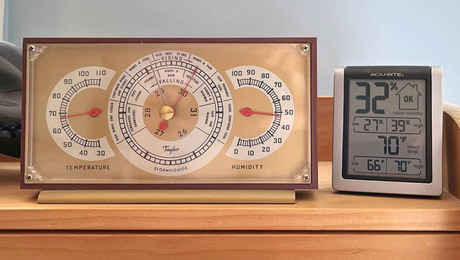I am going to replace my old patio. I was thinking about using brick pavers around the edge and for the expansion joint lines. Do I set the pavers first and use them for the forms for the pour. Does anyone know how to do this. I live in lower Michigan so freeze-thaw is an issue. The ground is well drained clay. I plan to compact crushed limestone into the clay for the base. Is this the right thing to do?
Joe Phillips
Plastics pay the bills, Woodworking keeps me sane!


















Replies
Well drained clay? Don't think so.
If you do a seperate pour for brick edge and bands (joints), make sure the depth of pour will accomodate your freeze-thaw. Using the brick as form is possible (use foam expansion joint between brick and slab, good quality caulk system for resulting joint), but separate formed pour before brick is installed will be cleaner for brick. Or reverse pour - slab first, then brick base.
Different, but needs more forming and finishing expertise: Form entire slab, sufficient edge depth for freeze-thaw, block out where brick will go with forming. Make sure to carefully and gradually taper excavation for transition at different depths - cracks form where concrete thicknesses are different.
We do this a lot for our cusomers. They all want brick patios ($$$) and don't want plain concrete, hence the compromise.
We pour the concrete first, framing/blocking out for brick joints (width=1brick + 2 mortar joints). The joint blocking is sometimes ripped to 3", this being the depth of 1 brick and .5" mortar bed. If not, make sure your joint footing doesn't come above the bottom of the two boards forming the board, otherwise they'll be trapped. This means a slightly thicker mortar bed. Joints must be dug deeper so the joints have a footing. And follow the other poster's advice and taper your soil grade down towards the brick footing.
Brick edges also get a second form, 3" lower than concrete grade and the width is reduced by one mortar joint width. It's advisable to choose your brick first - not all brick are the same. And knowing that most of our brick are 3.75" = 4.25" w/ joint helps us choose concrete dimensions accordingly.
Set your brick using the concrete as a finish height. A simple 2x4 works as a leveler. A wood or mag trowel is handy too, to help prevent the previous brick from getting pushed up as you push the adjacent brick down (The mortar is displaced).
Remember, these brick joints are your control joints. Place them accordingly. Your cracks will appear at the concrete/mortar interface. So we use a simple roundover trowel to form the mortar down at the concrete edge. This creates a weak spot at the interface for any cracking - and it's recessed. Brick to brick mortar joints are tooled/pointed as usual.
These joints becoming features of the concrete, so they may cross each other (remember the widths of brick, so your joints cross on full brick), or they may curve.
And we reinforce all our concrete with wire. We usually dig for joints, then gravel, then wire, then joint frame. This way the wire is continuous pad to pad. And we put rebar in the joints as well.
well first you need to add the bricks before the concrete sets up, or they will just set on top.
Ideally you would add them during the mixing stage.
but this could be LOUD!!
and you would need a BIG mixer.
plus it will make your mix lumpyand hard to float.
maybe you should stick with stones??
We always get it right!!!
the third time....
"Almost certain death, small chance of success.... What are we waiting for???"
Mr. T.
LOL How did you know I wanted to use tumbled pavers?
Thanks for the help guys.
If I pour the slabs first can I set the pavers in just paver sand or should I pour concrete footers? How deep should the footers be? Should the rebar and screen extend from slab to slab under the pavers? Sounds hard to form around.
Joe Phillips
Plastics pay the bills, Woodworking keeps me sane!
Ok, I dug out all of the loose fill down to undisturbed clay. I know need to back fill 16". I was advised to use 21-AA limestone. I figure I will need 24 yards and 21-AA is expensive. Do I have options?
Joe Phillips
Plastics pay the bills, Woodworking keeps me sane!
i laid about 1100 ft2 of paver a couple years back... out here on the west coast they offer class 2 baserock " A recycled product composed of fines and 3/4" crushed concrete. It is used underneath foundations, pathways, patios, and driveways. It is used as a base underneath concrete and asphalt. Class 2 Base Rock meets the Cal Trans spec "
if i recall, i used around 45 tons... and on the SF peninsula is goes for $17 a ton
"I was advised to use 21-AA limestone."What is 21-AAStone and rock terms are not standardized and there are a thousand different local terms for the same thing.What about 3/4" crusher run. Locally that is called AB3 or Roadbase.It is cushed linestone as it comes out of the crusher and includes every that that is 3/4" or smaller.Packs well.
Bill,
Same stuff, only 1 1/2" and smaller.
Joe Phillips
Plastics pay the bills, Woodworking keeps me sane!